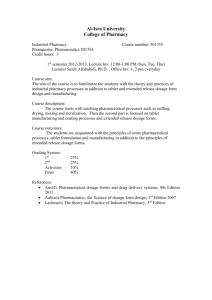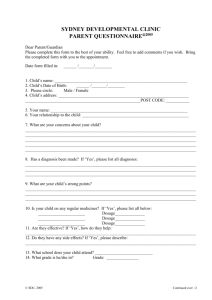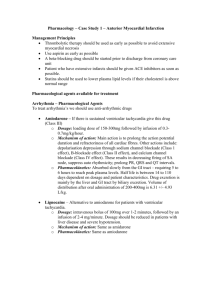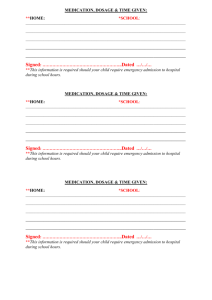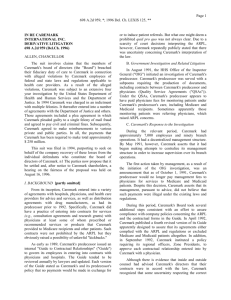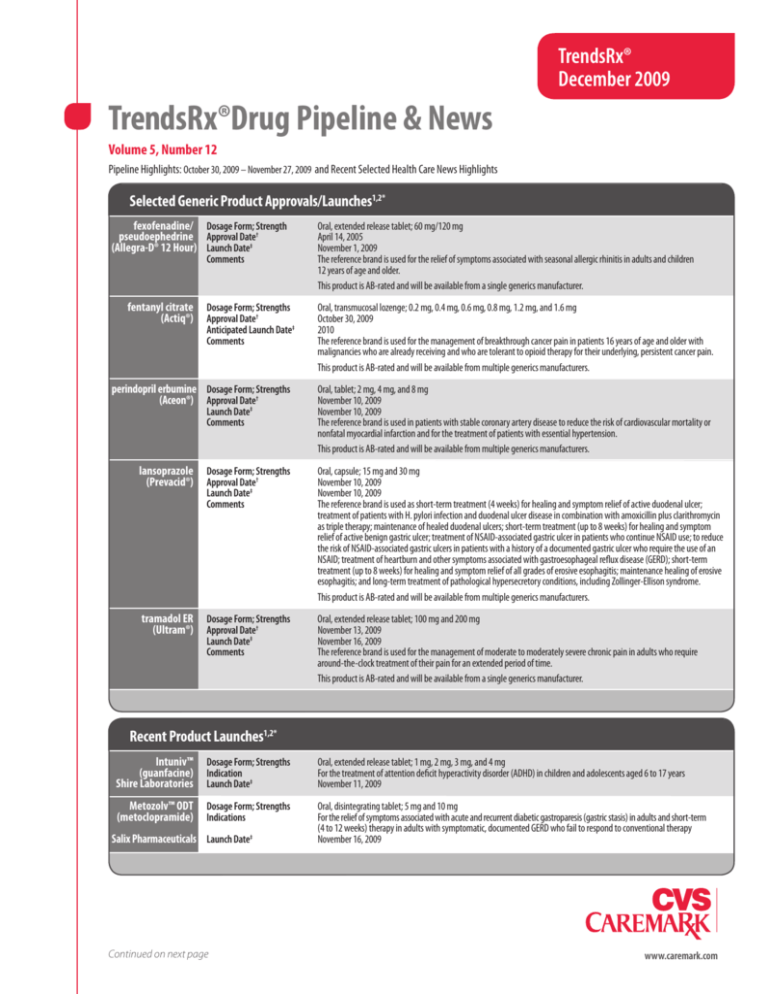
TrendsRx®
December 2009
TrendsRx®Drug Pipeline & News
Volume 5, Number 12
Pipeline Highlights: October 30, 2009 – November 27, 2009 and Recent Selected Health Care News Highlights
Selected Generic Product Approvals/Launches1,2*
fexofenadine/ Dosage Form; Strength
pseudoephedrine Approval Date†
(Allegra-D® 12 Hour) Launch Date‡
Oral, extended release tablet; 60 mg/120 mg
April 14, 2005
November 1, 2009
The reference brand is used for the relief of symptoms associated with seasonal allergic rhinitis in adults and children
12 years of age and older.
This product is AB-rated and will be available from a single generics manufacturer.
fentanyl citrate Dosage Form; Strengths
(Actiq®) Approval Date†
Anticipated Launch Date‡
Comments
Oral, transmucosal lozenge; 0.2 mg, 0.4 mg, 0.6 mg, 0.8 mg, 1.2 mg, and 1.6 mg
October 30, 2009
2010
The reference brand is used for the management of breakthrough cancer pain in patients 16 years of age and older with malignancies who are already receiving and who are tolerant to opioid therapy for their underlying, persistent cancer pain.
This product is AB-rated and will be available from multiple generics manufacturers.
perindopril erbumine Dosage Form; Strengths
(Aceon®) Approval Date†
Launch Date‡
Comments
Oral, tablet; 2 mg, 4 mg, and 8 mg
November 10, 2009
November 10, 2009
The reference brand is used in patients with stable coronary artery disease to reduce the risk of cardiovascular mortality or nonfatal myocardial infarction and for the treatment of patients with essential hypertension.
This product is AB-rated and will be available from multiple generics manufacturers.
lansoprazole Dosage Form; Strengths
(Prevacid®) Approval Date†
Launch Date‡
Comments
Oral, capsule; 15 mg and 30 mg
November 10, 2009
November 10, 2009
The reference brand is used as short-term treatment (4 weeks) for healing and symptom relief of active duodenal ulcer;
treatment of patients with H. pylori infection and duodenal ulcer disease in combination with amoxicillin plus clarithromycin as triple therapy; maintenance of healed duodenal ulcers; short-term treatment (up to 8 weeks) for healing and symptom relief of active benign gastric ulcer; treatment of NSAID-associated gastric ulcer in patients who continue NSAID use; to reduce the risk of NSAID-associated gastric ulcers in patients with a history of a documented gastric ulcer who require the use of an NSAID; treatment of heartburn and other symptoms associated with gastroesophageal reflux disease (GERD); short-term treatment (up to 8 weeks) for healing and symptom relief of all grades of erosive esophagitis; maintenance healing of erosive esophagitis; and long-term treatment of pathological hypersecretory conditions, including Zollinger-Ellison syndrome.
This product is AB-rated and will be available from multiple generics manufacturers.
tramadol ER Dosage Form; Strengths
(Ultram®) Approval Date†
Launch Date‡
Comments
Oral, extended release tablet; 100 mg and 200 mg
November 13, 2009
November 16, 2009
The reference brand is used for the management of moderate to moderately severe chronic pain in adults who require around-the-clock treatment of their pain for an extended period of time.
This product is AB-rated and will be available from a single generics manufacturer.
Comments
Recent Product Launches1,2*
Intuniv™ Dosage Form; Strengths
(guanfacine) Indication
Shire Laboratories Launch Date‡
Oral, extended release tablet; 1 mg, 2 mg, 3 mg, and 4 mg
For the treatment of attention deficit hyperactivity disorder (ADHD) in children and adolescents aged 6 to 17 years
November 11, 2009
Metozolv™ ODT Dosage Form; Strengths
(metoclopramide) Indications
S alix Pharmaceuticals Launch Date‡
Oral, disintegrating tablet; 5 mg and 10 mg
For the relief of symptoms associated with acute and recurrent diabetic gastroparesis (gastric stasis) in adults and short-term
(4 to 12 weeks) therapy in adults with symptomatic, documented GERD who fail to respond to conventional therapy
November 16, 2009
Continued on next page
www.caremark.com
Recent New Drug Application (NDA) Approvals1,2*
Pennsaid®
(diclofenac sodium)
Mallinckrodt/
Nuvo Research
Dosage Form; Strength
Indication
Approval Date
Anticipated Launch Date‡
Topical, solution; 1.5% w/w
For the treatment of signs and symptoms of osteoarthritis of the knee
November 4, 2009
First Quarter 2010
Lysteda™ (tranexamic acid)
Xanodyne Pharmaceuticals
Dosage Form; Strength
Indication
Approval Date
Anticipated Launch Date‡
Oral, tablet; 650 mg
For the treatment of cyclic heavy menstrual bleeding
November 13, 2009
Fourth Quarter 2009
Qutenza™ (capsaicin) Dosage Form; Strength
NeurogesX
Indication
Approval Date
Anticipated Launch Date‡
Topical, transdermal patch; 8% (640 mcg/cm2)
For the management of neuropathic pain associated with postherpetic neuralgia
November 16, 2009
First Half 2010
Recent Supplemental New Drug Application (sNDA) Approvals1,2*
Byetta® (exenatide) Dosage Form Indication
Approval Date
Eli Lilly/Amylin Comments
Geodon® Dosage Form (ziprasidone) Indication
Pharmaceuticals
Injection, subcutaneous
For use as monotherapy, along with diet and exercise, to improve glycemic control in adults with type 2 diabetes mellitus
October 30, 2009
This is a new indication for an already approved product.
Refer to full Prescribing Information for a complete list of indications.
Approval Date
Comments
Pfizer
Oral, capsule
For maintenance treatment of bipolar I disorder as an adjunct to lithium or valproate in adults
November 20, 2009
This is a new indication for an already approved product.
Refer to full Prescribing Information for a complete list of indications.
Abilify® Dosage Forms (aripiprazole) Indication
Bristol-Myers Squibb
Company/Otsuka Approval Date
Pharmaceutical Comments
Co., Ltd
Oral, tablet; oral, disintegrating tablet; oral, solution
For the treatment of irritability associated with autistic disorder in pediatric patients ages 6 to 17 years, including symptoms of aggression towards others, deliberate self-injuriousness, temper tantrums, and quickly changing moods
November 19, 2009
This is a new indication for an already approved product.
Refer to full Prescribing Information for a complete list of indications.
Recent Biologic License Application (BLA) Approval1,2*
Agriflu® (influenza Dosage Form
virus vaccine) Indication
Approval Date
Novartis Vaccines and Anticipated Launch Date‡
Diagnostics Limited
Injection, intramuscular
For the active immunization of adults 18 years of age and older for the prevention of disease caused by influenza virus subtypes A and type B contained in the vaccine
November 27, 2009
December 2009
Recent Supplemental Biologic License Application (sBLA) Approval1,2*
Influenza A (H1N1) Dosage Form
2009 Monovalent Indication
Vaccine
Approval Date
GlaxoSmithKline/ Anticipated Launch Date‡
ID Biomedical
Injection, intramuscular
For the active immunization of persons age 18 years of age and older against influenza disease caused by pandemic (H1N1) 2009 virus
November 10, 2009
December 2009
Continued on next page
www.caremark.com
Recent Prescription to OTC Switch2,3*
Prevacid® 24 HR Dosage Form; Strength
(lansoprazole) Indication
Approval Date
Launch Date‡
Comments
Novartis Oral, delayed-release capsule; 15 mg
For the treatment of frequent heartburn that occurs two or more days per week
May 18, 2009
November 12, 2009
Prevacid® 24 HR will be the first OTC proton pump inhibitor (PPI) introduced into the U.S. market since Prilosec OTC® was approved in 2003.
OTC=over-the-counter
* Adapted from RxPipeline Services Week In Review. For more information, contact: pipeline@caremark.com<mailto:pipeline@caremark.com>
†
The Approval Date is established by the FDA but does not necessarily mean a generic product is available as of that date or that such product is available.
‡
A launch date/anticipated launch date may not reflect the actual availability of this medication. Due to circumstances beyond the control of CVS Caremark,
information related to prospective medication launch dates is subject to change without notice. This information should not be solely relied upon for decision-making purposes.
News
Medication Safety
Information regarding selected medication safety issues can be found on the CVS Caremark Web site at www.caremark.com > Health Professional Services >
Drug Safety Alerts.
FDA Issues Public Health Advisory on Plavix and Omeprazole Due to Drug Interactions4
As of November 17, 2009, the FDA has new data showing that omeprazole reduces the anticoagulant effect of clopidogrel
(Plavix®) by about half when these two medicines are taken concurrently. Patients at risk of heart attack or stroke who use
clopidogrel to prevent blood clots will not get the full effect of this medicine if they are also taking omeprazole (applicable to
both prescription and non-prescription omeprazole). Subsequently, the severity level of this interaction was raised to clinically
significant, and the concurrent use of these agents should be avoided. The clopidogrel label will be updated to include more
details about this drug-drug interaction. The FDA made the following other points:
• Taking clopidogrel and omeprazole separately will not reduce this drug interaction.
•
Other drugs that should not be combined with clopidogrel because they may have a similar interaction include
esomeprazole (Nexium®), cimetidine (Tagamet® and Tagamet HB®, available with or without a prescription), fluconazole (Diflucan®), ketoconazole (Nizoral®), felbamate (Felbatol®), fluoxetine (Prozac®, Serafem®, Symbyax®), fluvoxamine (Luvox®), and ticlopidine (Ticlid®).
• At this time, the FDA does not have sufficient information about drug interactions between clopidogrel and proton pump inhibitors other than omeprazole and esomeprazole to make specific recommendations about their co-administration.
• Patients who need a medication to reduce stomach acid can use antacids and the acid reducers, Zantac® (ranitidine),
Pepcid® (famotidine) and Axid® (nizatidine). The FDA does not believe these medicines will stop or limit the anticoagulant activity of Plavix®. Ranitidine and famotidine are available with or without a prescription.
Additional information is available at the FDA Web site: http://www.fda.gov/NewsEvents/Newsroom/PressAnnouncements/
ucm191169.htm.
This medication safety issue has been reviewed and addressed by the CVS Caremark Drug Safety Alert program.
Continued on next page
www.caremark.com
Clinical Guidelines
Focused Update: Revised Guidelines for the Prophylactic Use of Beta Blockers5
On November 2, 2009, the American College of Cardiology (ACC) and the American Heart Association (AHA) released a
Focused Update to the Practice Guidelines for the Prophylactic Use of Beta Blockers. The update was based on new clinical
trial data highlighting the risks and benefits of using beta blockers to reduce cardiac events during noncardiac surgeries. It
provides specific recommendations regarding which patients will likely benefit and patients for whom there is not enough
evidence to recommend their use. Beta blockers may be considered in:
• Patients undergoing vascular surgery whose stress tests or existing coronary artery disease show them to be at high risk of heart attack or other cardiac complications
• High-risk patients undergoing intermediate-risk surgery and patients undergoing vascular surgery who have multiple risk factors for complications (e.g., diabetes, a history of heart failure, significant kidney disease)
Beta blockers should be started cautiously. They should be initiated well before the procedure and titrated up as blood pressure
and heart rate allow. According to the guideline’s authors, the usefulness of beta blocker prophylaxis remains uncertain in
lower-risk patients and in patients undergoing lower-risk surgeries; their risks and benefits require careful consideration.
AHA/SCAI Guidelines on Percutaneous Coronary Intervention6
On November 18, 2009, new recommendations were released in focused updates to two guidelines: the ACC/AHA Guidelines
on ST-Elevation Myocardial Infarction (STEMI) and Guidelines on Percutaneous Coronary Intervention (PCI) by the ACC/AHA/
Society for Cardiovascular Angiography and Interventions. A major change was the addition of prasugrel (Effient®) to the
guidelines. Prasugrel is now a recommended alternative to clopidogrel (Plavix®) in these situations. Despite an increase in
bleeding, prasugrel exceeded clopidogrel in the net clinical benefit endpoint, which included all-cause mortality, ischemic
events, and major bleeding events. Although prasugrel can be used for patients with STEMI undergoing PCI, it should not be used
as part of dual antiplatelet therapy in patients with a history of stroke and transient ischemic attack.
References
1.
2.
3.
4.
5.
6.
CVS Caremark. RxPipeline. Available at: www.caremark.com/wps/portal/client. Accessed November 6, 2009; November 13, 2009; November 20, 2009; and November 27, 2009.
Drugs@FDA. Rockville, MD: Food and Drug Administration, Center for Drug Evaluation and Research. Available at: http://www.accessdata.fda.gov/scripts/cder/drugsatfda/index.cfm. Accessed November 2009.
Novartis launches Prevacid® 24HR over-the-counter for full 24-hour frequent heartburn treatment [press release]. Basel, Switzerland: Novartis AG; November 12, 2009. http://www.novartis.com/newsroom/media-releases/en/2009/1354451.shtml. Accessed November 12, 2009.
FDA News. FDA Announces New Warning on Plavix: Avoid Use with Prilosec/Prilosec OTC. Food and Drug Administration Web site. http://www.fda.gov/NewsEvents/Newsroom/PressAnnouncements/ucm191169.htm. Accessed November 20, 2009.
Fleischmann KE, Beckman JA, Buller CE, et al. 2009 ACCF/AHA focused update on perioperative beta blockade. A report of the American College of Cardiology Foundation/American Heart Association Task Force on Practice Guidelines. American Heart Association Web site. http://circ.ahajournals.org/cgi/reprint/CIRCULATIONAHA.109.192689. Accessed November 20, 2009.
Kushner FG, Hand M, Smith Jr SC, et al. 2009 Focused Updates: ACC/AHA Guidelines for the Management of Patients With ST-Elevation Myocardial Infarction (Updating the 2004 Guideline and 2007 Focused Update) and ACC/AHA/SCAI Guidelines on Percutaneous Coronary Intervention (Updating the 2005 Guideline and 2007 Focused Update). A Report of the American College of Cardiology Foundation/American Heart Association Task Force on Practice Guidelines. American Heart Association Web site. http://circ.ahajournals.org/cgi/reprint/CIRCULATIONAHA.109.192663v1. Accessed November 20, 2009.
© 2009 Caremark. All rights reserved. Any names and trademarks listed herein are the property of their respective manufacturers.
Please note: This document provides a brief overview of various subjects. This letter is provided as reference material and is based in part
on information derived from third parties. Caremark does not assume liability or responsibility for the accuracy or completeness of any
third-party material footnoted in this letter. Caremark does not operate the Web sites listed here, nor is it responsible for the availability or
reliability of their content. These listings do not imply or constitute an endorsement, sponsorship or recommendation by Caremark.
www.caremark.com

